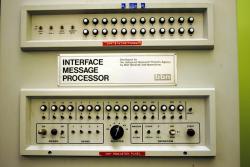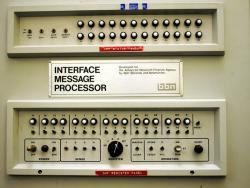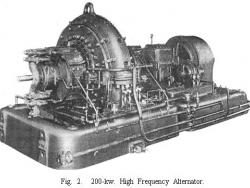"The Alexanderson radio alternator was a high-power, radio-frequency source which provided reliable transoceanic radiotelegraph communication during and after World War I. Ernst F.W. Alexanderson (1878-1975), a General Electric engineer, designed radio alternators with a frequency range to 100 kHz and a power capability from 2 kW to 200 kW.
Communications

YearAdded:
Image Credit: Public Domain; Produced prior to 1/1/1923Image Caption: Alexanderson Radio AlternatorEra_date_from: 1904
1992

"At 10:30 p.m., 29 October 1969, the first ARPANET message was sent from this UCLA site to the Stanford Research Institute. Based on packet switching and dynamic resource allocation, the sharing of information digitally from this first node of ARPANET launched the Internet revolution."
(The plaque can be seen at the UCLA Henry Samueli School of Engineering and Applied Sciences, 405 Hilgard Ave., Los Angeles, California, U.S.A.)
The deployment of the ARPANET set in motion a train of developments that led to the Internet as we know it today.
YearAdded:
Image Credit: Courtesy Flickr/FastLizard4 (CC BY-SA 2.0)Image Caption: The original Interface Message Processor, a primitive router, and considered widely to be the beginning (or "birth") of the internetEra_date_from: 1969
2009

"Driven by the need to understand the characteristics of radio communication in Canada's North, Canadian researchers focused on the exploration of the earth's upper atmosphere, the ionosphere. Canada's satellite program commenced with the launch of Alouette-I on September 29, 1962. Alouette-II followed in 1965, ISIS-I in 1969, ISIS-II in 1971. The Alouette/ISIS tracking antenna serves as a reminder of Canada's contribution to this international effort in space science.
YearAdded:
Image Credit: Public Domain; NASAImage Caption: The The Alouette 1, the very first satellite constructed by CanadaEra_date_from: 1962
1993
Innovations

"Driven by the need to understand the characteristics of radio communication in Canada's North, Canadian researchers focused on the exploration of the earth's upper atmosphere, the ionosphere. Canada's satellite program commenced with the launch of Alouette-I on September 29, 1962. Alouette-II… Read More

"At 10:30 p.m., 29 October 1969, the first ARPANET message was sent from this UCLA site to the Stanford Research Institute. Based on packet switching and dynamic resource allocation, the sharing of information digitally from this first node of ARPANET launched the Internet revolution."
(The plaque… Read More

"The Alexanderson radio alternator was a high-power, radio-frequency source which provided reliable transoceanic radiotelegraph communication during and after World War I. Ernst F.W. Alexanderson (1878-1975), a General Electric engineer, designed radio alternators with a frequency range to 100 kHz… Read More


